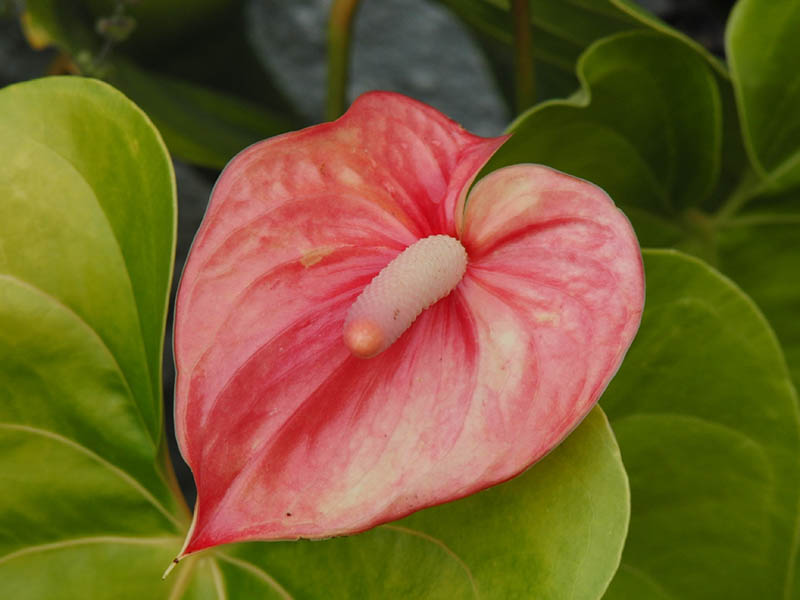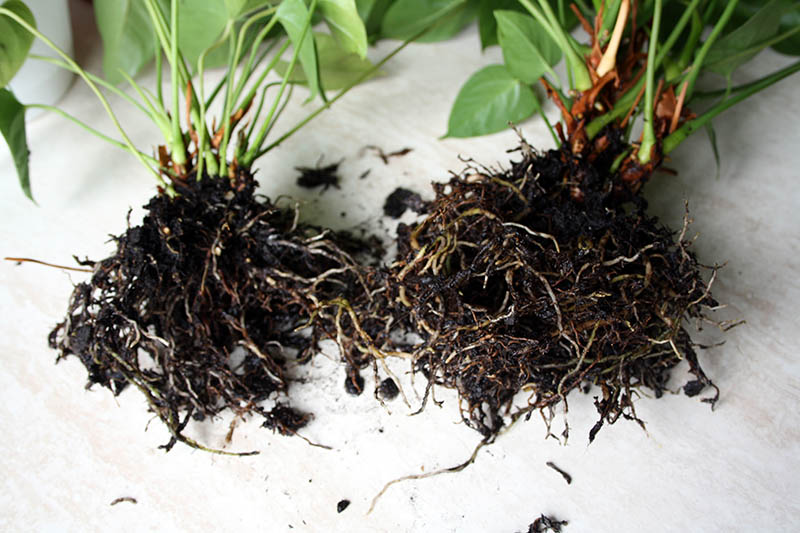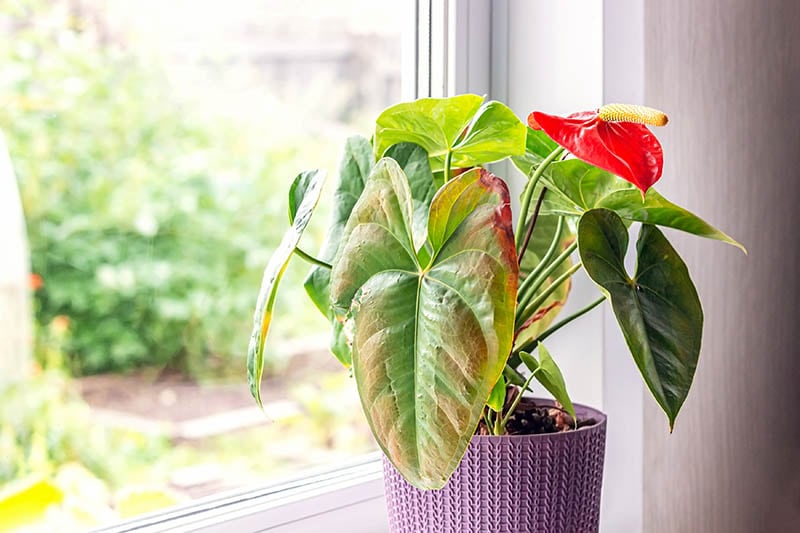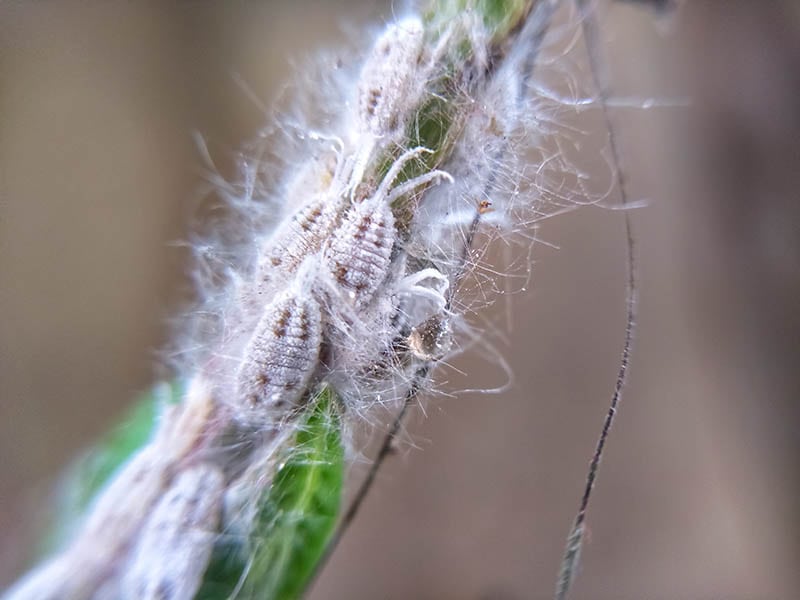Why Are My Anthurium Flowers Dying? 6 Likely Reasons
-
Ashley Bates
- Last updated:

Growing flowers is a rewarding and time-consuming task. Each one requires slightly different care, and some can be very finicky and fickle. Even when doing all you can, you might notice that your beloved anthurium appears to be dying—but why?
If you’re growing anthurium flowers and notice browning or wilting, there’s an environmental factor causing the issue. In this case, there isn’t one possibility. So, we will go over each potential root cause of the decline so you can get your flowers back to a healthy state.
Reasons Why Your Anthurium Flowers Dying
1. Root Rot and Water Mold
The most common mistake when you own an anthurium plant is overwatering or lack of proper drainage. These potted plants do not do well in soil that is too moist. You can wait until the plant completely dries out before adding more water.
Root Rot
If the roots are exposed to too much water, stagnant air, improper lighting, or high humidity for some time, it can cause the roots to deteriorate. Bacteria and viruses thrive in moist environments, and since your anthuriums don’t like excessive water, they will be weaker.
If not treated promptly, this condition can be deadly. Fast action is the quickest route to resolve. So, here are the signs you’re looking for:
- Slow growth
- Mushy stems
- Distorted leaves
- Rancid soil smell
- Reddish brown leaves (if visible)
Correcting Root Rot
Here are some things to try to eliminate a root rot condition. Keep in mind, this may not work with very advanced cases.
- Gently remove the plant from the pot.
- Remove all dirt gently from around the roots.
- Use sterilized scissors to cut off rotten roots.
- Trim back the dead or damaged foliage from your plant.
- Discard the original soil.
- Wash the pot thoroughly with a bleach and water solution.
- Treat roots with a fungicide.
- Repot the plant with fresh soil.
We want to stress the importance of thoroughly cleansing the pot before placing it back in. Even if you change the soil, traces of the fungus can still reinfect the plant if it exists elsewhere.
Water Mold
Anthurium can suffer from phytophthora and Pythium oomycetes. They tend to mirror the same symptoms as root rot, and you can follow the same basic steps to eliminate the problem. However, the actual fungus is rarely witnessed with these two fungal issues.
Fungicides such as mefenoxam can be very effective in correcting the issue, too.

2. Anthurium Is Sensitive to Drafts and Extreme Temperatures
Anthuriums thrive in temperatures between 70 and 85 degrees, making them ideal for indoor growing. Keeping your anthurium near vents or drafty windows can cause a decline in health.
Keep these plants in a well-lit room, away from anything that could trigger a major temperature change.
For example, be sure to keep them away from reptile enclosures, as the extra heat might be too much for them. Areas in the home with a lot of moisture, like bathrooms, might be too humid for them, causing a decline.
Being very close to windows, especially in cold months, can cause some major damage to leaves on your anthurium, too. Floor and ceiling vents can be a problem as well, so check for potential culprits in the area where your plant is stored.

3. Your Anthurium Suffers from a Lack of Proper Pruning
When anthuriums bloom, it’s best to prune them once they start to decline. This allows the plant to direct its energy toward new bloom development. If you don’t routinely prune these plants, it might not necessarily kill them, but it can cause your plant to look less healthy.
To prune your anthurium plant, follow these simple steps:
- Remove any dead or discolored leaves.
- Remove wilted flowers with sterilized scissors from the stem at the base.
And there you have it! Your anthurium can now invest its bountiful energy toward new stems and blooms instead.
4. Your Anthurium Might Have a Disease
Pests can be widespread in houseplants, and your anthurium isn’t immune. Here are a few diseases that could affect your plant.
Bacterial Blight
Bacterial blight is a fungus that can form on your plant leaves. These leaves can quickly turn yellow, and then brown, wilting the plant. Fungicides are useful when treating this particular sneaky little devil.
Bacterial Wilt
As the name implies, bacteria enter the vascular parts of the plant, causing drooping and wilting in the stems or stalks.
Black Nose Disease
This disease steals the beauty from your anthurium’s lovely blooms. It starts with tiny black flecks on the floral spadix and rapidly grows, turning the spadix to mush. This is an especially damaging disease for florists, as it can devastate bloom potential in plants.

5. Your Anthurium Might Have Unwanted Pests
Your anthurium can get unwanted visitors living in the soil or feasting on their leaves. These pesky critters can rob your plant of vital nutrients, causing it to decline rapidly. Some might go unnoticed and cause minimal damage while others can be detrimental to your anthurium’s overall health.
Here are a few pests along with their visual signs:
Aphids
Aphids are very common pests among houseplants. Typically, these bugs transmit from outdoor plants to indoor plants if you get them near each other.
Severe aphid damage shows curling or twisted leaves, yellowing, dead shoots, and a lack of normal growth. Aphids can quickly rob your plant of nutrients, so take care of the problem as soon as you notice.
Often, you can find aphids clustered under leaves or on stalks. However, if the infestation is significant, you might have to take alternate action. You can wipe the leaves down with a soft alcohol-doused cloth to remove these pests.
Mealybugs
Mealybugs are recognizable because of a white waxy substance on plants. These bugs are present by yellowing leaves, stunting growth, and eventually killing the host. These bugs suck out the sap from the plant, causing a weakening of the overall anthurium, leaving behind a waste substance called honeydew.
If not dealt with promptly, mealybugs can devastate your plants. The honeydew left behind on plants will develop noticeable mold, making these intruders easy for the trained eye to identify.
Mealybugs require ongoing treatment to eradicate, but it’s usually successful if you catch it early enough. You simply spray the whole plant with a rubbing alcohol and water base a few times per week for a few weeks.

Spider Mites
Spider mites are actually true itsy-bitsy arachnids that invade houseplants. These invasive critters create chlorotic spots, stippled patches, and leaf webbing.
If you see actual house spiders in your soil or on your plants, this can be another telltale sign you’re dealing with spider mites. These mites serve as a food source for many spider species and will attract them to the area.
The most effective way to get rid of spider mites is to treat the soil and leaves relentlessly until no trace remains. Sometimes, you might have to replant and separate other healthy plants until the problem is solved.
Thrips
Thrips are another common pest for anthuriums. These tiny bugs can do serious damage, as they use the plant as a food source and a reproduction hotspot. Females lay eggs inside the plant tissue, and the adults and larvae feed on the host.
Thrips are proven to be very hard to control once you have them. They cause worrisome signs like papery leaves, pale spots, and leaf drop.
The best method to get rid of thrips is to dislodge the bugs by spraying them forcefully off with warm water. If you cannot, you can also take a cloth and wipe down individual parts of the plant.
Getting Rid of Bugs
Once you identify the pests, you need to isolate affected plants until the problem is resolved. Work diligently to use a combination of methods to solve your infestation. If all-natural methods fail, you can use a commercial pesticide, provided it isn’t dangerous to pets or children in the home.
If you catch any of these pests quickly enough, you can get by with rinsing the plant thoroughly and removing topsoil.
In Conclusion
There can be many causes of a dying anthurium, so only you can look for telltale signs of what might be wrong. While these are the most common reasons, several factors and environmental specifics are at play, so there is no guarantee the problem made our list.
In most cases, you can easily identify the problem to get your anthurium back to thriving. In the meantime, isolate your anthurium from other houseplants until it has a clean bill of health.
- https://bloomscape.com/common-issue/why-is-my-anthurium-losing-flowers/
- https://plantcaretoday.com/anthurium-pests-diseases.html
- https://extension.umn.edu/yard-and-garden-insects/aphids
- https://extension.umd.edu/resource/mealybugs-indoor-plants
- https://www.wildinteriors.com/blog/2019/10/30/treating-root-rot-and-soft-rot-in-houseplants?format=amp
Contents


